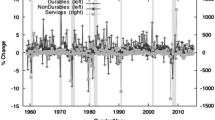Abstract
This paper analyses the effects of money shocks on macroeconomic aggregates in a tractable flexible-price, incomplete-markets environment that generates persistent wealth inequalities amongst agents. In this framework, current inflation redistribute wealth from the cash-rich employed to the cash-poor unemployed and induce the former to increase their labour supply in order to maintain their desired levels of consumption and precautionary savings. If the shocks are persistent, however, they also raise inflation expectations and thus deter the employed from saving and supplying labour. We relate the strength of these two inflation taxes to the underlying parameters of the model and study how they compete in determining the overall sign and slope of the implied ‘output–inflation tradeoff’ relation.
Similar content being viewed by others
References
Akyol A.: Optimal monetary policy in an economy with incomplete markets and idiosyncratic risk. J Monet Econ 51, 1245–1269 (2004)
Ball L., Mankiw N.G., Romer D.: The New Keynesian economics and the output–inflation trade-off. Brookings Papers Econ Activity 1988(1), 1–82 (1988)
Berentsen A., Camera G., Waller C.: The distribution of money balances and the nonneutrality of money. Int Econ Rev 46(2), 465–487 (2005)
Bewley T.: The optimum quantity of money. In: Kareken J.H., Wallace N. (eds.) Models of Monetary Economies. Federal Reserve Bank of Minneapolis, Minneapolis
Bewley T.F.: A difficulty with the optimum quantity of money. Econometrica 51(5), 1485–1504 (1983)
Camera G., Corbae D.: Money and price dispersion. Int Econ Rev 40(4), 985–1008 (1999)
Cooley T.F., Hansen G.D.: The inflation tax in a real business cycle model. Am Econ Rev 79(4), 733–748 (1989)
Doepke M., Schneider M.: Aggregate implications of wealth redistribution: the case of inflation. J Eur Econ Assoc 4(2–3), 493–502 (2006)
Green E.J., Zhou R.: A rudimentary random-matching model with divisible money and prices. J Econ Theory 81, 252–271 (1998)
Imrohoroglu A.: The welfare cost of inflation under imperfect insurance. J Econ Dyn Control 16, 79–91 (1992)
Jappelli T.: Who is credit constrained in the U.S. economy?. Q J Econ 105(1), 219–234 (1990)
Kehoe T.J., Levine D.: Liquidity constrained markets versus debt constrained markets. Econometrica 69(3), 575–598 (2001)
Kehoe T.J., Levine D.K., Woodford M.: The optimum quantity of money revisited. In: Dasgupta, P., Gale, D., Hart, O., Maskin, E. (eds) Economic Analysis of Markets and Games, MIT Press, Cambridge (1992)
Lagos R., Wright R.: A unified framework for monetary theory and policy analysis. J Polit Econ 113(3), 463–483 (2005)
Levine D.K.: Asset trading mechanisms and expansionary policy. J Econ Theory 54(1), 148–164 (1991)
Lucas R.E. Jr: Some international evidence on output–inflation tradeoffs. Am Econ Rev 63(3), 326–334 (1973)
Molico M.: The distribution of money and prices in search equilibrium. Int Econ Rev 47(3), 701–722 (2006)
Scheinkman J.A., Weiss L.: Borrowing constraints and aggregate economic activity. Econometrica 54(1), 23–45 (1986)
Uhlig H.: A toolkit for analysing nonlinear dynamic stochastic models easily. In: Marimon, R., Scott, A. (eds) Computational Methods for the Study of Dynamic Economies, Chap. 2, pp. 30–61. Oxford University Press, Oxford (2001)
Walsh C.E.: Monetary Theory and Policy. MIT Press, Cambridge (2003)
Author information
Authors and Affiliations
Corresponding author
Additional information
We are particularly grateful to Chris Carroll, Jean-Michel Grandmont, Guy Laroque, Etienne Lehmann, Victor Rios-Rull, and two anonymous referees for their suggestions on earlier versions of this paper. We also received helpful comments from seminar participants at CREST-INSEE and participants at the 2007 T2M Conference (Paris) and the 2007 EEA-ESEM meeting (Budapest). Financial support from the French National Research Agency (ANR Grant no JCJC0157) is gratefully acknowledged. The usual disclaimers apply.
Rights and permissions
About this article
Cite this article
Algan, Y., Challe, E. & Ragot, X. Incomplete markets and the output–inflation tradeoff. Econ Theory 46, 55–84 (2011). https://doi.org/10.1007/s00199-009-0499-0
Received:
Accepted:
Published:
Issue Date:
DOI: https://doi.org/10.1007/s00199-009-0499-0




